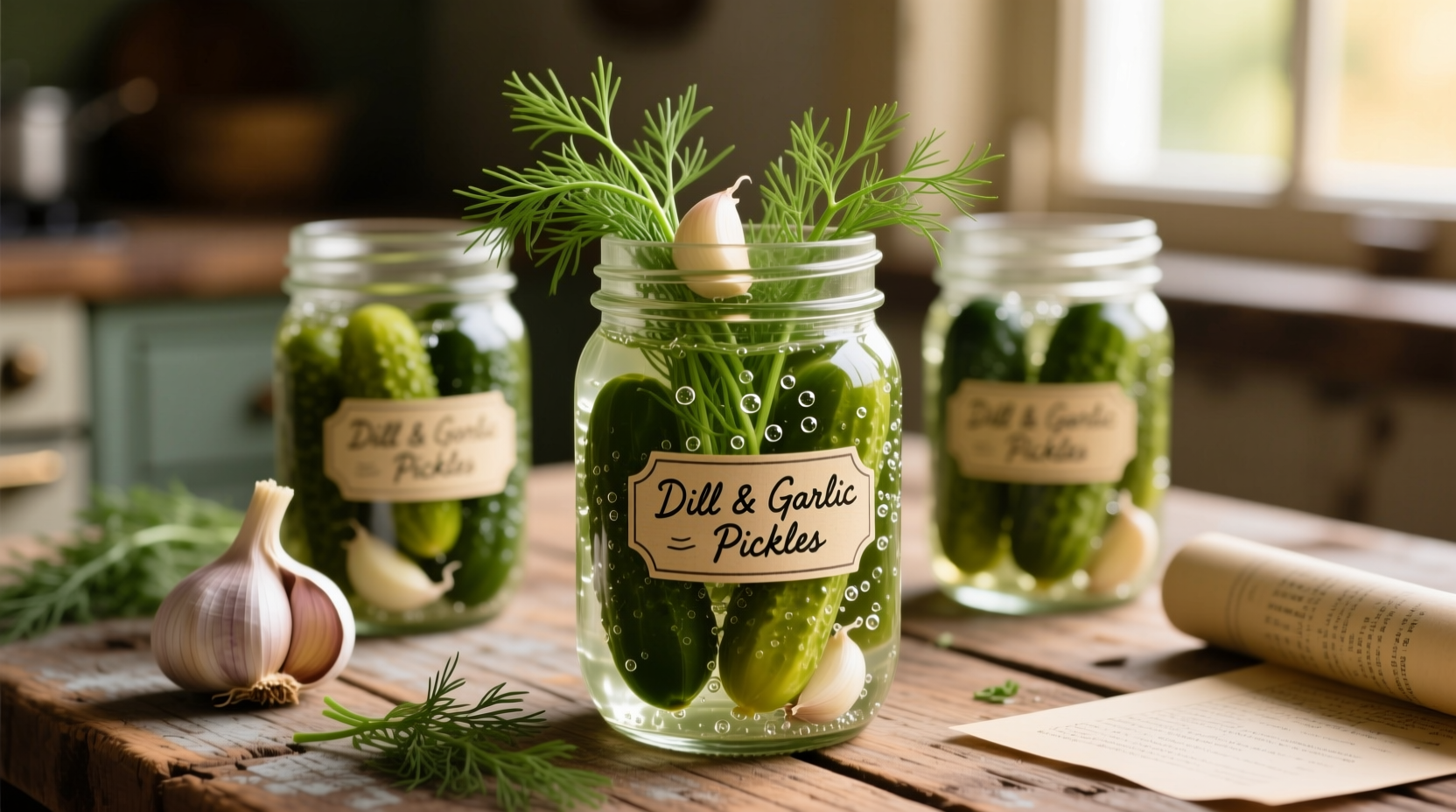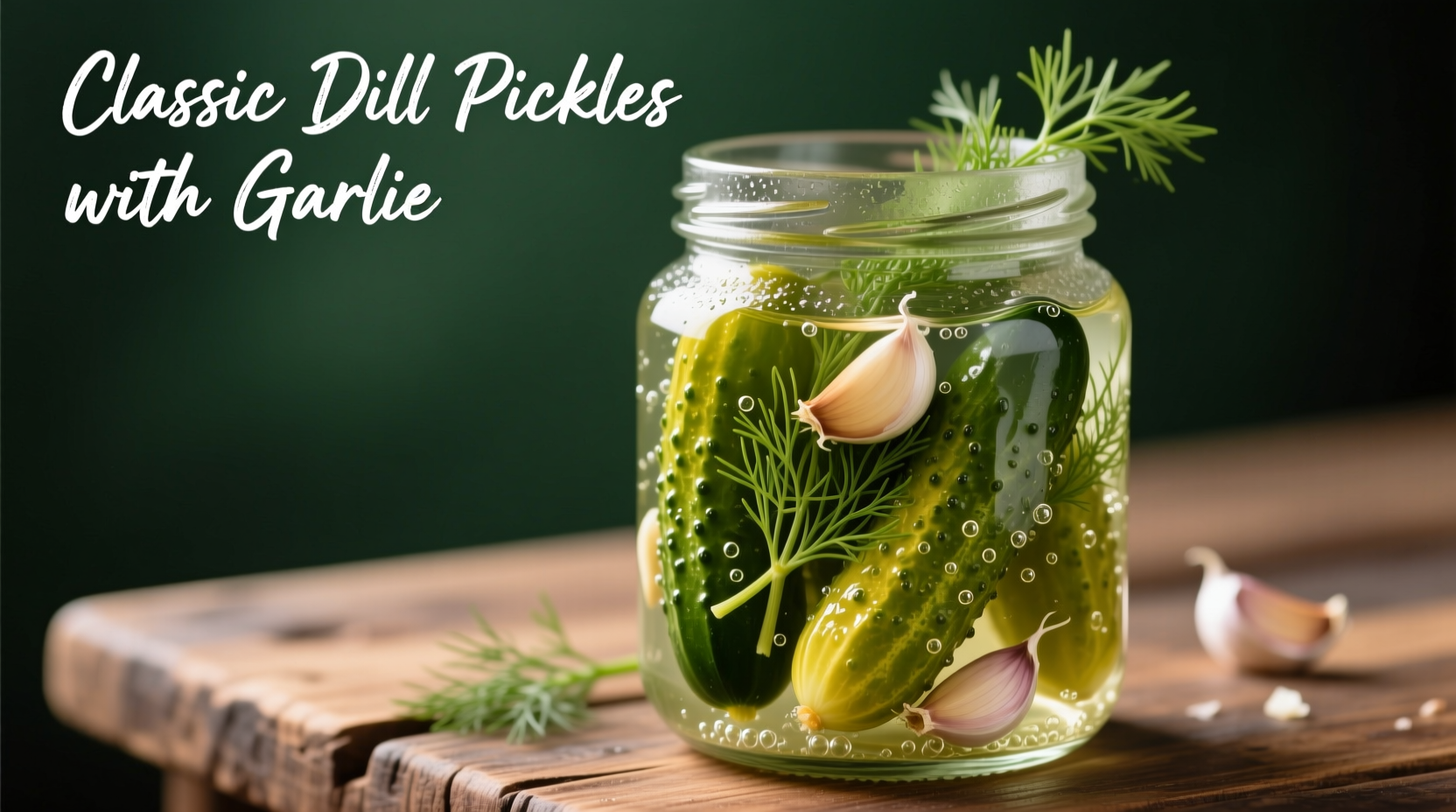There's nothing quite like homemade dill pickles with garlic—the crisp texture, the perfect balance of tangy vinegar and fresh dill, and that unmistakable garlic kick. Forget store-bought versions with questionable preservatives; this recipe delivers authentic flavor while meeting all current food safety standards for home canning.
Why This Dill Pickle Recipe Works
Most failed pickle attempts stem from improper vinegar ratios or inadequate processing. This recipe follows USDA guidelines for safe home canning while preserving that fresh, crisp texture you want. The secret lies in the precise vinegar-to-water ratio, the addition of grape leaves for tannins, and the careful temperature control during processing.
| Vinegar Type | Acidity Level | Recommended for Pickling? | Notes |
|---|---|---|---|
| Distilled White Vinegar (5% acidity) | 5% minimum | ✓ Yes | Standard for most pickle recipes; provides clean flavor |
| Apple Cider Vinegar | 5% minimum | ✓ Yes | Adds subtle fruit notes; may darken pickles slightly |
| Wine Vinegar | 5-7% | △ Sometimes | Use only in tested recipes; flavor varies significantly |
| Rice Vinegar | 4-5% | ✗ No | Too weak for safe canning; requires recipe adjustment |
Source: USDA Complete Guide to Home Canning (2023 edition), Table 3-1: Vinegar Selection Guidelines
Perfect Dill Pickles with Garlic: Ingredients
- 4 pounds fresh pickling cucumbers (2-4 inches long)
- 3 cups distilled white vinegar (5% acidity)
- 3 cups water
- 1/4 cup pickling or kosher salt (not iodized)
- 8-10 garlic cloves, peeled and smashed
- 4 heads fresh dill (or 4 tablespoons dill seed)
- 8-10 grape leaves or 1/2 teaspoon black tea leaves (for crispness)
- 1 tablespoon mustard seeds (optional)
- 1 teaspoon red pepper flakes (optional)
Essential Equipment Checklist
Before starting your recipe for dill pickles with garlic, gather these items:
- 10 half-pint canning jars with new lids and bands
- Canning pot with rack (or large stockpot)
- Jar lifter and funnel
- Non-reactive saucepan (stainless steel)
- Small bowl for measuring spices
- Clean kitchen towels
Step-by-Step Canning Process
Follow this precise timeline for safe, crisp dill pickles with garlic:
- Prepare jars (15 minutes): Wash jars in hot soapy water, rinse well, and keep hot. Simmer lids in water (do not boil) until ready to use.
- Prepare cucumbers (10 minutes): Wash thoroughly. Trim 1/16 inch from blossom end (critical for crispness). Leave whole or slice as desired.
- Create brine (5 minutes): Combine vinegar, water, and salt in saucepan. Bring to boil, stirring to dissolve salt.
- Fill jars (10 minutes): Place 1 garlic clove, 1 dill head, and 1 grape leaf in each jar. Pack cucumbers tightly. Pour hot brine over cucumbers, leaving 1/2 inch headspace.
- Process (15 minutes active, 20 minutes processing): Wipe rims, apply lids and bands. Process in boiling water bath: 10 minutes at sea level, 15 minutes 1,000-3,000 ft, 20 minutes 3,001-6,000 ft, 25 minutes above 6,000 ft.
- Cool and store (24 hours): Remove jars, cool upright for 12-24 hours. Check seals, remove bands, store in cool dark place.
This processing timeline follows the National Center for Home Food Preservation's updated 2024 guidelines for safe canning at various altitudes. The precise timing ensures proper vacuum seal formation while maintaining crisp texture.
Common Problems and Solutions
Even with the best recipe for dill pickles with garlic, issues can arise. Here's how to troubleshoot:
- Mushy pickles: Caused by improper blossom end trimming, insufficient tannins, or overprocessing. Always trim 1/16 inch from blossom end and include grape leaves.
- Cloudy brine: Usually from using table salt with iodine or anti-caking agents. Always use pickling or kosher salt without additives.
- Weak flavor: Insufficient dill or garlic, or not allowing proper curing time. Let pickles cure 4-6 weeks before eating for best flavor development.
- Failed seals: Improper headspace, food particles on rim, or incorrect processing time. Always check seals after 24 hours by pressing lid center.
Storage and Usage Tips
Properly canned dill pickles with garlic will maintain best quality for 12-18 months when stored in a cool, dark place (50-70°F). Once opened, refrigerate and consume within 2 months. For optimal flavor development, wait at least 4 weeks before eating your homemade pickles.
These pickles make excellent additions to charcuterie boards, sandwiches, or as a standalone snack. Try adding them to potato salad for a tangy twist, or chop finely for homemade tartar sauce.

Flavor Variations to Try
Once you've mastered the basic recipe for dill pickles with garlic, experiment with these professional variations:
- Spicy garlic dills: Add 1-2 sliced jalapeños per jar along with the garlic
- Sweet garlic dills: Add 1/4 cup sugar to the brine for a sweet-tangy profile
- Herb-infused: Add fresh tarragon, oregano, or thyme alongside the dill
- Smoked garlic version: Use smoked garlic cloves for a deeper flavor profile
Remember that any recipe modifications should maintain the proper vinegar-to-water ratio (1:1 minimum) to ensure food safety. The Penn State Extension's 2023 Home Canning Guide confirms that altering acid levels compromises safety without proper pH testing.
Why Canning Safety Matters
Home canning requires strict adherence to tested guidelines because improperly processed foods can harbor Clostridium botulinum, the bacteria that causes botulism. This odorless, tasteless toxin can be fatal. The USDA emphasizes that "altering vinegar, food, or water proportions can create an environment where harmful bacteria can grow." Always follow scientifically tested recipes like this one for dill pickles with garlic to ensure safety.
Final Thoughts
Creating perfect dill pickles with garlic at home is both an art and a science. By following this tested recipe and understanding the principles behind each step, you'll consistently produce crisp, flavorful pickles that surpass anything you can buy commercially. The initial investment of time pays off with jars of delicious, shelf-stable pickles that capture summer's freshness for months to come.











 浙公网安备
33010002000092号
浙公网安备
33010002000092号 浙B2-20120091-4
浙B2-20120091-4